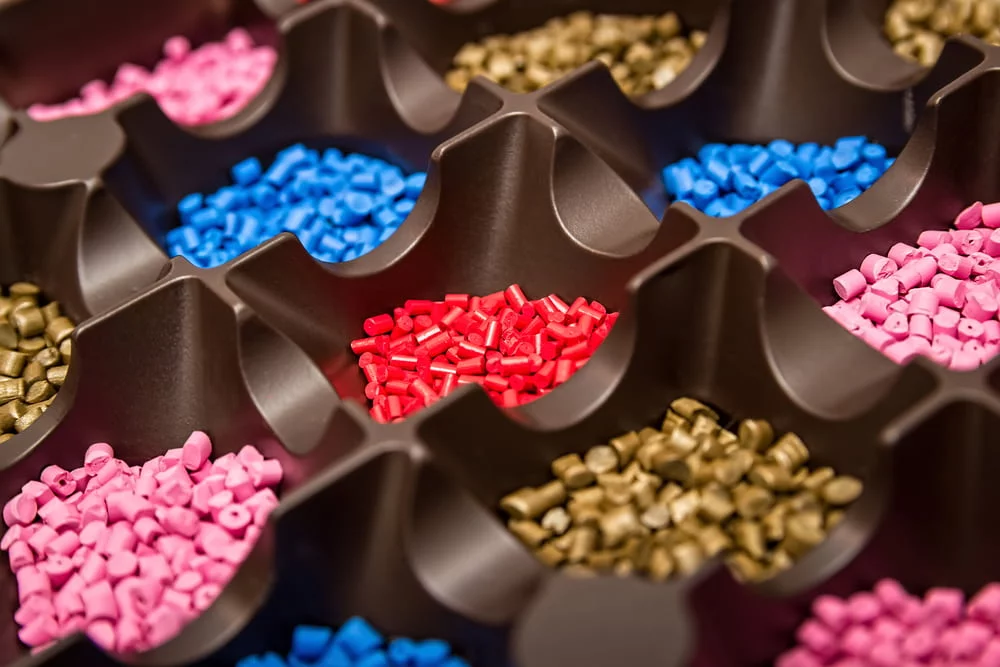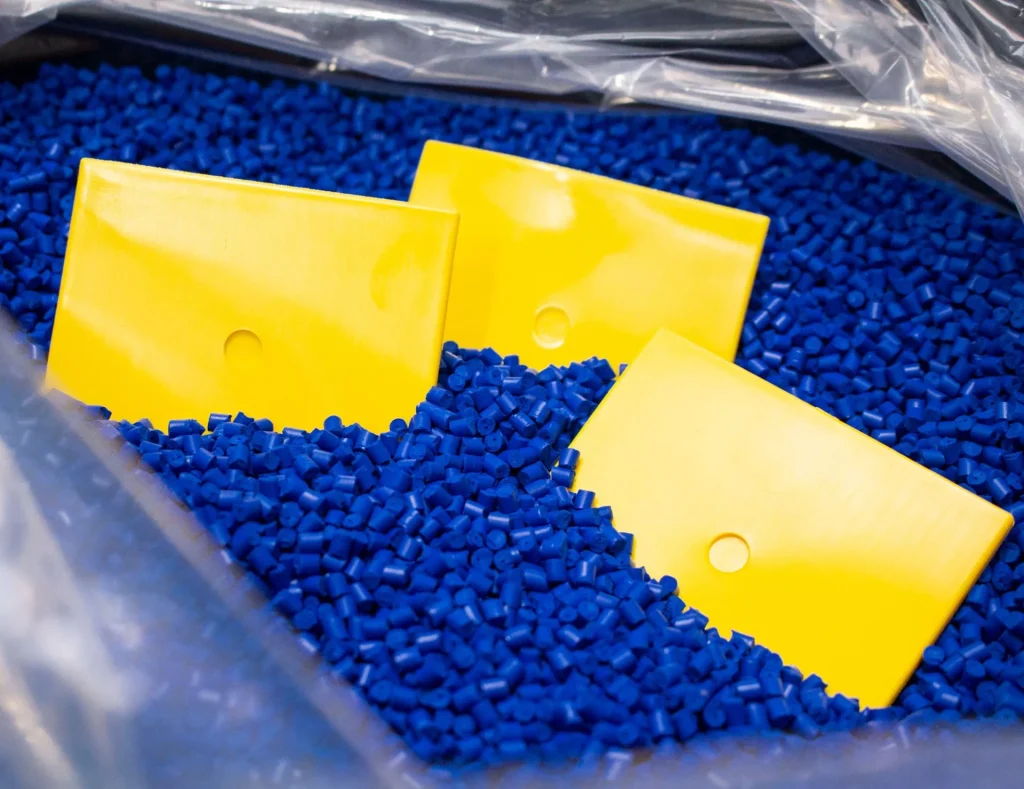The injection molding process is one of the fastest ways to simultaneously produce large quantities of the same plastic part. Injection molding can be used for virtually any consumer plastic product. Electronics, automotive, healthcare, and aerospace industries use plastic materials to create various parts with different functions and specifications. Due to the wide range of applications, different parts require different material formulations. Therefore, selecting plastic materials is one of the most important steps when manufacturing plastic products.
The injection molding process uses thermoplastics, making material selection difficult for the abovementioned reasons. Plastic materials used for injection molding range from commonly used polymers to specialty plastics and polymer blends, with hundreds of different plastic resins, each with different properties and processing requirements. In addition, the same plastic materials have different registrations, including resin types with fillers such as glass and carbon fibers. The combination of all these factors causes it to become a daunting task for engineers to select the right material for injection molding projects in general.
This article covers plastics commonly used in injection molding, material properties, and more.
Whether your project involves injection molding medical plastics, molding plastic parts for automobiles, or something else, Elimold’s expert engineers are ready to help you with everything from design, material selection, mold design, and manufacturing to high-volume production.

What is a thermoplastic?
A thermoplastic is a material that is usually a plastic polymer. This means that it can be reused once melted by remelting, remolding, and refreezing. Thermoplastics are plastics that melt when heated, making plastic injection molding possible. Because of this versatility, most modern plastic products are made from thermoplastics. There is a wide variety of plastic injection molding materials with different uses and properties. There are the very strong and hard ones that are melted and remolded on the back side and the flexible and rubber-like ones. Some are transparent, and some are opaque. This diversity makes thermoplastics one of the most popular, common, and widely used materials in the world today.
The Most Common and Popular Injection Molding Materials
The following are some of the most common and popular plastic materials used in plastic injection molding:
Acrylonitrile Butadiene Styrene (ABS)
ABS resin is an opaque thermoplastic polymer that is a typical thermoplastic injection molding material and is an engineering-grade plastic.ABS has a relatively low melting point and is easy to mold. It is tough, dimensionally stable, impact-resistant, scratch resistant, and unbreakable. In addition, the low melting temperature makes it easy to mold.
This opaque polymer supports the use of colorants as well as a variety of textures and surface finishes. Its butadiene content provides excellent toughness even at low temperatures, and its styrene content imparts a shiny, attractive finish to injection-molded parts. However, one of its effects is that it scratches easily, making it very fragile. In addition, it can be very damaging to the environment because it is made from petroleum and produces thermoplastic fumes during manufacturing.
Nylon Polyamide (PA)
Nylon is the name of a family of synthetic polymers consisting of polyamide (PA). Nylon is a synthetic polyamide (PA), also known as polymer fabric, a filamentary thermoplastic. It combines toughness with high heat resistance, abrasion resistance, good fatigue resistance, and acoustic properties. Due to its diverse properties, it is one of the most versatile injection molding materials. Nylon can be combined with other materials to enhance its properties; for example, nylon is not flame retardant by itself, but combined with other materials, it can become an explosive version. In addition, it can be degraded by sunlight, and adding UV stabilizers can improve UV resistance. Nylon is less resistant to strong acids and bases than other plastics. Nylon is not as strong as polypropylene and does not match polycarbonate for impact resistance. Injection molding nylon is challenging because it tends to shrink and underfill molds.
Polycarbonate (PC)
Polycarbonate is a high-performance, clear, engineering-grade thermoplastic. It has excellent optical properties and is extremely durable, making it one of the most durable plastic materials. It is lightweight, strong, and can withstand significant deformation without breaking or even stress fracture. It can also be used in higher-temperature environments due to its relatively high melting point (155°C). Although polycarbonate is a strong, rigid injection molding material, it is not scratch resistant. However, it is also resistant to discoloration but will turn yellow with prolonged exposure to UV light.
Polyoxymethylene (POM)
Polyoxymethylene (POM) is an engineering plastic also known as acetal. It is a semi-crystalline polymer that is very hard and has a natural glossy finish, making it a useful material in a variety of industries. It combines excellent rigidity and thermal stability with a low coefficient of friction. This plastic material has low water absorption and good chemical resistance. In terms of appearance, POM plastic is naturally opaque and white.POM is the most suitable material for producing heavy-duty industrial plastic parts. It scores high in all categories, such as heat and chemical resistance, but is also more difficult to work with during the molding stage. Disadvantages include difficulty in bonding, poor acid resistance, and susceptibility to ultraviolet light. Exposure to hydrochloric and nitric acids is undesirable.
Thermoplastic Rubber (TPR)
Thermoplastic rubber (TPR) is a unique material that is a mixture of plastic and rubber, combining the physical properties of both, and is easy to use in the injection molding process. It has excellent chemical and weathering resistance and high impact strength.TPR products exhibit a high degree of plasticity and can withstand long-term weathering.TPR is also highly resistant to chemicals.
Acrylic (PMMA)
Acrylic (PMMA) is also known as acrylic glass, complete with the chemical name: polymethyl methacrylate. It is a strong, transparent thermoplastic. It is well suited for structural applications due to its moldability and ability to mold to tight tolerances through injection molding. In addition, its properties are similar to glass, and it is often combined with various additives or fillers to enhance specific properties such as impact resistance, flame retardancy, chemical resistance, or UV filtration, making it an excellent, lightweight alternative to glass.

Plastic Material Comparison Chart
| Material | Approximate Tensile Strength | Flexibility | Impact Strength | Electrical Insulation | Temperature Resistance | Chemical Resistance | FDA Compliant | Cost (low to high) | Water Resistant |
| Acrylic (PMMA) | 8000 psi | low | low | no | high | strong | no | medium | yes |
| Acrylonitrile Butadiene Styrene (ABS) | 5900 psi | high | high | no | low | medium | no | medium | yes |
| Nylon Polyamide (PA) | 12400 psi | high | high | yes | high | strong | yes | high | yes |
| Polycarbonate (PC) | 9500 psi | high | high | no | high | weak | yes (can contain bisphenol A, or BPA) | high | yes |
| Polyethylene (PE) | 1400 psi (LDPE) 3480 – 6530 psi (HDPE) 800 – 13100 psi (PET) | medium (LDPE) low (HDPE) high (PET) | high (LDPE) high (HDPE) low (PET) | yes | low | strong (LDPE) strong (HDPE) strong (PET) | yes | low | yes |
| Polyoxymethylene (POM) | 6400 – 10600 psi | medium | high | yes | high | strong | yes | high | |
| Polypropylene (PP) | 4800 psi | high | medium | yes | medium | strong | yes | low | yes |
| Polystyrene (PS) | 2560 – 7690 psi | medium | high | no | medium | yes | low | yes | |
| Thermoplastic Elastomer (TPE) | 290 – 8200 psi | high | high | no | low | strong | no | high | yes |
| Thermoplastic Polyurethane (TPU) | 4060 – 13900 psi | high | no | high | strong | yes | medium | yes | |
| PC/ABS | 7000 psi | low | high | no | medium | strong | yes | low | yes |
| PC/PBT | 7830 – 12000 psi | low | high | yes | high | medium | yes | medium | yes |
| PPE/PS | 6500 psi | low | medium | no | high | medium | yes | medium | yes |
Get help choosing the right material for your project today!
We hope this overview will help you understand some of the most popular injection molding materials and their properties and applications. Choosing the right injection molding material is critical to product quality, budget planning, and long-term success. At Elimold, we use our years of experience and in-depth knowledge of injection molding to help your business, including knowing what you need to know from concept to design, mold making, material selection, production, part assembly, and finished product. Contact Elimold today to request a free quote for your project.
Go to the full page to view and submit the form.
